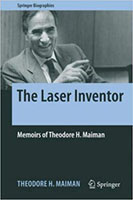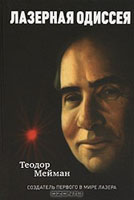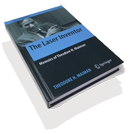LASER INVENTOR
CREATOR OF THE WORLD'S FIRST LASER
 |
 |
 |
The Laser Odyssey
The laser's genesis has been historically misunderstood. In The Laser Odyssey (published in 2000), author Theodore Maiman, creator of the first laser, reveals how and why the laser really came about and exposes common myths about the laser's creation.
Beginning with tales from childhood and early work experiences, Maiman recounts the course of his education up to his days in the Stanford Physics "Basement" where he worked on his doctoral thesis under Nobel Laureate Willis Lamb.
Dr. Maiman takes readers through the sociological, technological, and political obstacles that challenged and inspired him in the development of the laser. He describes the response of a startled scientific community when he produced the first man-made coherent light using a design approach that had been scoffed at, condemned, and discarded by acclaimed scientists in the field.
The Laser Odyssey will appeal to many, from the general reader who will easily absorb the essential qualities of laser technology to the sophisticated science buff.
In 2010, the year of the 50th anniversary of the laser, The Laser Odyssey was translated and edited in Russian language.
Ten years later Polish version has been published by PWN (Polish Scientific Publishers) under the title "Odyseja laserowa".
The Laser Inventor. Memoirs of Theodore Harold Maiman
The book, published in 2018 by the distinguished scientific publisher Springer, is an extended version of the Laser Odyssey. It includes photos and documentary materials related to T. Maiman's life and accomplishments never before published.
Excerpt from both books:
It was the afternoon of May 16, 1960; it was time to confirm or deny all the fears of why the "ruby can't work"; Or, why "lasers can't be made to work." No more new calculations, no more diversionary experiments. This was the moment of truth!
The laser head was mounted on a workbench. The flashlamp was connected to the power supply. The trigger electrode was connected to the spark coil, (the mechanism that initiates the flash from the strobe lamp). The light output from the coupling hole in the end of the ruby was directed through the Bausch and Lomb monochromator to a photomultiplier tube, (a very sensitive form of photoelectric cell). The electrical signal from the photomultiplier was connected to the Hughes Memoscope.
Irnee D'Haenens and I were the only ones performing and observing the experiment.
We first took a test shot so that we could adjust the monitoring equipment. We turned up the power supply to about 500 volts. We fired the flashtube. Indeed, we observed a trace on the Memoscope!
That trace was a recording of the red ruby fluorescence. The decay in the trace was about three milliseconds, the lifetime of the upper possible laser level. We made the appropriate adjustments to optimize the monitor display.
We continued. We progressively increased the supply voltage, each time monitoring and recording the light output trace. As we did so, the peak output increased proportionately to the energy output and the decay time remained the same … So far, so good.
But, when we got past 950 volts on the power supply, everything changed! The output trace started to shoot up in peak intensity and the initial decay time rapidly decreased.
Voila. This was it!
The laser was born!
What Readers are Saying:
"The world is indebted to you for your invention" - Jimmy Carter, former US President.
"The Laser Odyssey is filled with excitement and adventure ordinary scientists will never dream of encountering in a million years…a fun, intriguing, fascinating, and enlightening book." - Hiroshi Kimurah, physical chemist, Los Angeles, California.
"The book was an eye opener…it gave me immense satisfaction and pleasure to read through Maiman's struggles. As I read on, I understood the categorical proof of why things never worked on the first optical maser. It made me happy to have had a first hand account from the creator of the LASER himself. STUBBY RUBY WORKED AND ROCKED THE WORLD!!! Congratulations to Dr. Maiman for bringing out the truth to an ordinary physics student. This is one book, which compelled me to finish it in one night! I wish we had teachers and physicists like Dr. Maiman who would not be afraid to stand up and call a spade a spade with honor and integrity." - Raj Kombiyil, physics student, Fairbanks Alaska.
"I was enthralled by your book...I must say, you hit the nail on the head every time, right to the point... It was fascinating as you paraded all those characters-Birnbaum, Lyons, Stitch, etc. Your character analysis was superb!" - Irwin Hahn, physics professor, University of California, Berkeley.
"The story of your red bow tie has become legendary talk in our Foundation." - Morihisa Kaneko, Executive Officer, The Science and Technology Foundation of Japan.
"Beside Theodore Maiman's interesting biography, the laser story is laid out fully, truthfully and within the proper context. The truth always comes out in the end but it never hurts to help it along." - Bernard Soffer, optical physicist, Los Angeles, California.
"The Laser Odyssey is an amazing book. You have a great gift for clarity in your writing and a narrative style, which makes the book very personal and believable. It exudes warmth which is like you are and at the same time gives the impression that you are not one to avoid a fight." - Harold Parker, Attorney at Law, San Francisco, California.
"It is a wonderful book and you have every reason to be proud of it... I like the tone - very much. Historians of science will (have to) pay attention to the details you have provided. Every young scientist should take note of your important lessons: healthy skepticism and being a maverick are necessary qualities to build the confidence that you need to explore uncharted territories prior to any discovery." - Jacob Kuriyan, physicist/software entrepreneur, Albuquerque, New Mexico.
"The book is a joy to read...it is also an historical contribution setting the record straight on lasers. It will be widely read I'm sure." - Arnold Kramish, nuclear physicist, Washington, DC.
"The Laser Odyssey brought back a mass of memories and emotions as I read of Dr. Maiman's recollections and personal struggles. There is much in the book that confirmed my own memories of the devious obstacles that Hughes and the science establishment dealt out as we went about the goals of work. I recall the worry and frustration that I also felt about some of the people we were supposed to depend on for leadership and insight in those days. I think we knew then that we were all fragile, and for that matter still are if not more so, but Dr. Maiman somehow had the guts to count on himself and make a path to accomplishment." - Don Devor, optical physicist.
"I am delighted that this has finally come into print for everybody needs to know about your great achievements." - Stephen Joffe, laser surgeon/entrepreneur and LASIK industry pioneer, Cincinnati, Ohio.
Foreward to the Russian Edition
I am proud to write as the spouse of Ted Maiman as well as a beneficiary of the countless gifts that the laser has bestowed on mankind. The laser is a gift that we are still unwrapping. In addition to its ever-expanding applications in science, industry, medicine, and consumer uses, the laser offers promise of a still more monumental development. Laser fusion would provide carbon-free, inexpensive, and inexhaustible energy our future needs for the survival of mankind. The gifts of laser technology are boundless and limited only by man's imagination.
Before May 16, 1960, there was no laser—no real proof, no demonstrated hard evidence that visible coherent light could be generated. Eminent scientists of the day asserted that coherent light could not be achieved by man. A gutsy scientist was needed to go against the conventional wisdom; a clever maverick with both physics insight and engineering finesse was needed to make a device capable of generating coherent light. A device was needed to demonstrate that Einstein was correct when he worked out the underlying theory governing the behavior of coherent light.
On May 16, 1960, my late husband Ted Maiman startled the scientific community when he demonstrated for the first time coherent light for humanity's benefit. Coherent light emerged from a design he had conceived, developed, and constructed. A design so good that it is the basic design of lasers today. His ruby laser, both simple and elegant, made possible a startling quantum leap of 10,000 times the frequency from the microwave domain in a single step. From Ted's first laser all other lasers have flowed, and even those with different designs were inspired by the example of that first laser that demonstrated coherent light.
History records Ted's achievements, but what I treasure as the most precious gift was to know and be loved by Ted Maiman the man. I knew him as a husband, my best friend, and a supportive partner to share all of life's joys and sorrows. Ted provided the kind of partnership as an equal in what I believe is the most important element for happiness.
I was Ted's wife for twenty-three years. I met him for the first time following his induction into the Inventors Hall of Fame. I felt an immediate comfort as if I had known Ted all my life. The experience was magical, and as I later learned, Ted conveyed the same natural ease, warmth, and modesty to others. Ted's accomplishments, combined with his intelligence, could have led to impatience with me and others. But it didn't. He was always tolerant of other people and full of respect for them. I know that everyone who worked with Ted admired his straightforward honesty and integrity. He did not force his ideas on others, but he had that extra drop of courage to listen to himself when everyone else told him he was wrong.
Simplicity is the ultimate sophistication. Ted's laser was practical and elegant. Ted's manner and approach to love, life, and work was easygoing and honest. Ted Maiman, the man, and Ted Maiman's world's first laser were both pinnacles of elegance and sophistication.
-Kathleen Maiman, 2010


The Books
The Laser Odyssey, released in 2000, gives an inside account of the invention of the laser and tells the story from Ted Maiman's unique perspective.
The Laser Inventor, released in 2018 by Springer, is an extended version of the book. It is available widely, including at Amazon.com and Indigo.